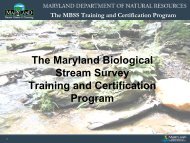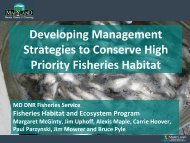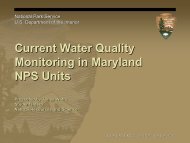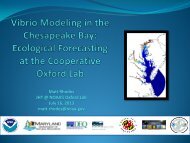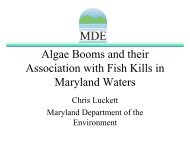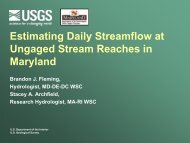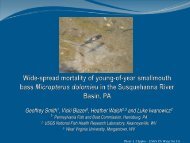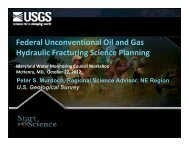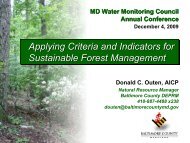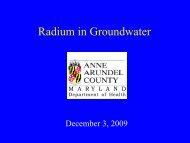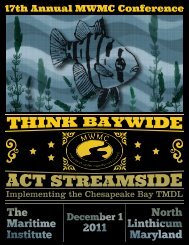Effect of Timing of Extreme Storms on Chesapeake - Maryland ...
Effect of Timing of Extreme Storms on Chesapeake - Maryland ...
Effect of Timing of Extreme Storms on Chesapeake - Maryland ...
You also want an ePaper? Increase the reach of your titles
YUMPU automatically turns print PDFs into web optimized ePapers that Google loves.
SAV Shoot Biomass<br />
(g C⋅m-2 )<br />
• <str<strong>on</strong>g>Extreme</str<strong>on</strong>g> storm events during the SAV<br />
growing seas<strong>on</strong> are detrimental, particularly<br />
during periods before peak shoot biomass.<br />
• <str<strong>on</strong>g>Extreme</str<strong>on</strong>g> storms during the SAV growing<br />
seas<strong>on</strong>, but after the shoot biomass peak, are<br />
estimated to be less detrimental. In the<br />
simulated tidal-fresh SAV community, the<br />
November extreme event has no effect <strong>on</strong><br />
SAV shoot biomass as the shoot biomass<br />
during this time is already in a normal, natural<br />
decline leading to an absence <str<strong>on</strong>g>of</str<strong>on</strong>g> SAV shoot<br />
biomass by December.<br />
• In tidal-fresh SAV communities, the degree<br />
<str<strong>on</strong>g>of</str<strong>on</strong>g> diminuti<strong>on</strong> <str<strong>on</strong>g>of</str<strong>on</strong>g> SAV shoot biomass carries<br />
over as an “echo” <str<strong>on</strong>g>of</str<strong>on</strong>g> decreased SAV biomass<br />
in the sec<strong>on</strong>d year. This effect is due to the<br />
decrease in simulated shoot biomass carried<br />
forward by a decrease in simulated shoot<br />
biomass. By the third simulated year <str<strong>on</strong>g>of</str<strong>on</strong>g> SAV<br />
resp<strong>on</strong>se, the effect <str<strong>on</strong>g>of</str<strong>on</strong>g> extreme storms <strong>on</strong> SAV<br />
biomass is generally unobserved.<br />
• In the simulated polyhaline James SAV<br />
community, the SAV resp<strong>on</strong>se to extreme<br />
storms was similar to that <str<strong>on</strong>g>of</str<strong>on</strong>g> the tidal fresh<br />
with the excepti<strong>on</strong> <str<strong>on</strong>g>of</str<strong>on</strong>g> the November storm.<br />
In this case, the simulated November storm<br />
M<strong>on</strong>th<br />
Figure 9. Simulated and observed SAV shoot biomass for a polyhaline SAV community. Modeled (mean [solid<br />
line] and interval encompassing 95% <str<strong>on</strong>g>of</str<strong>on</strong>g> computati<strong>on</strong>s [dashed line]) and observed (mean [dot] and 95% c<strong>on</strong>fidence<br />
interval [vertical line through dot]) polyhaline SAV community (Zostera above-ground shoot biomass <strong>on</strong>ly).<br />
Observati<strong>on</strong>s from Moore et al. [11]. Model simulati<strong>on</strong> from Mobjack Bay (segment MOBPH, formerly WE4) using<br />
the 10,000-cell 1998 versi<strong>on</strong> <str<strong>on</strong>g>of</str<strong>on</strong>g> the <strong>Chesapeake</strong> Bay Water Quality Model. Source: Cerco et al. [9].<br />
is close to the sec<strong>on</strong>dary October peak in the<br />
polyhaline SAV community shoot biomass.<br />
The resulting decreased SAV shoot biomass<br />
in November carried over to a noticeable SAV<br />
decrease during the sec<strong>on</strong>d year.<br />
• <str<strong>on</strong>g>Timing</str<strong>on</strong>g> <str<strong>on</strong>g>of</str<strong>on</strong>g> storms relative to SAV growing<br />
seas<strong>on</strong>s causes different effects <strong>on</strong> SAV,<br />
c<strong>on</strong>sistent with the observati<strong>on</strong>s noted in the<br />
introducti<strong>on</strong> [3, 4, 5], though the model does<br />
not directly simulate some <str<strong>on</strong>g>of</str<strong>on</strong>g> these storms.<br />
REFERENCES<br />
1. R.A. Batiuk, P. Bergstrom, M. Kemp, and<br />
others. 2000. In: <strong>Chesapeake</strong> Bay Submerged<br />
Aquatic Vegetati<strong>on</strong> Water Quality, Habitat-<br />
Based Requirements, and Restorati<strong>on</strong> Targets:<br />
A Sec<strong>on</strong>d Technical Synthesis. USEPA<br />
<strong>Chesapeake</strong> Bay Program, Annapolis, MD. 217<br />
pp.<br />
2. L.C. Gallegos. 2001. Calculating optical water<br />
quality targets to restore and protect submersed<br />
aquatic vegetati<strong>on</strong>: Overcoming problems in<br />
partiti<strong>on</strong>ing the diffuse attenuati<strong>on</strong> coefficient<br />
for photosynthetically active radiati<strong>on</strong>.<br />
Estuaries 24: 381–397.<br />
183




